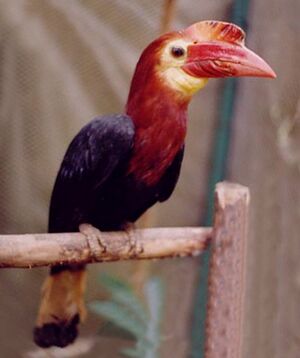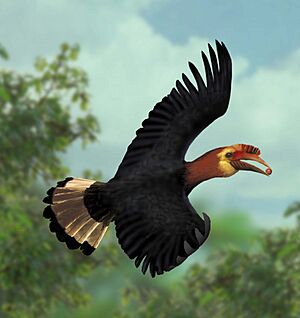Walden's hornbill facts for kids
Quick facts for kids Walden's hornbill |
|
|---|---|
 |
|
| male | |
| Conservation status | |
| Scientific classification | |
| Genus: |
Rhabdotorrhinus
|
| Species: |
waldeni
|
| Synonyms | |
|
Aceros leucocephalus waldeni |
|
The Walden's hornbill (Rhabdotorrhinus waldeni) is a special bird. People in the Philippines call it dulungan. It is also known as the Visayan wrinkled hornbill or rufous-headed hornbill. This bird lives in the rainforests on the islands of Negros and Panay in the Philippines.
Sadly, the Walden's hornbill is a critically endangered species. This means it is at a very high risk of disappearing forever. It is related to the writhed hornbill. You can tell them apart by the colors on their faces. Male Walden's hornbills have yellow skin around their eyes and throat. Females have blue skin there. The name Walden's comes from a Scottish bird expert named Viscount Walden.
This hornbill is one of the "Big 5" important animals in the Western Visayas region. The other four are the Negros bleeding-heart pigeon, Visayan spotted deer, Visayan hornbill, and the Visayan warty pig.
Contents
What Does It Look Like?
The Walden's hornbill is a large, rare bird. It lives in forests on Panay and Negros islands. It is almost gone from Negros. Most of its body is black. It has a cream-colored tail with a black band at the end. Its beak has a wrinkled part on the bottom. It also has an orange casque, which is a helmet-like growth on top of its beak.
Males and females look different. This is called sexual dimorphism.
- The male has a reddish-brown head.
- The male has yellow skin around its eyes and a yellow pouch on its throat.
- The female has a black head and neck.
- The female has blue and yellow skin around her eyes and on her chin.
- The female's beak and casque are smaller than the male's.
The only other hornbill in this area is the Visayan hornbill. But the Walden's hornbill is bigger. It also has a lighter-colored beak. Its call sounds like a deep, three-note chuckle.
Where It Lives and How It Behaves
Walden's hornbills live in thick forests. They can also be found in areas where trees have been cut. Sometimes, they visit single trees in open spaces. On Panay, they live at heights of 400 to 1,200 meters. On Negros, they live from 350 to 950 meters high.
They like places with lots of fruit trees to eat from. They also need large trees for their nests. These birds often live in small, noisy groups. Walden's hornbills nest in hollows found naturally in tree trunks. They can also use holes carved out by other animals.
Like other hornbills, they reproduce very slowly. Finding good nesting spots can be hard for them. To help, people are attaching special nest boxes to tree trunks in some protected areas.
These birds eat both plants and animals. They mostly eat fruits like figs from the tops of trees. But they also bring some animal matter to their nests. They might move around to different areas. This depends on where they can find food.
Why It Needs Our Help
The Walden's hornbill is a critically endangered species. It is one of three critically endangered hornbills. The others are the Sulu hornbill and the Helmeted hornbill. It is thought to be gone from Guimaras island. Now, it only lives on Negros and Panay.
Experts believe there are only about 1,000 to 2,499 adult birds left. This number keeps going down. The Walden's hornbill reproduces very slowly. This means it cannot recover quickly from dangers.
One big problem is hunting. Another is the cutting down of rainforests. By 2007, Negros had only 3% of its original forest left. Panay had only 6%. Most of these forests are at higher elevations. But this bird prefers lower areas. Even with so little forest left, trees are still being cut down. This happens because of legal and illegal logging. Forests are also cleared for farms, mining, and roads.
For example, a road was built through the Northwest Panay Peninsula Natural Park. This road separated it from the Central Panay Mountain Range. Roads make it easier for hunters and loggers to get into the forest.
Another huge threat is hunting and capture for the illegal wildlife trade. People called poachers steal the baby birds and their mothers from nests. They might climb the trees or even cut them down. This affects many nests.
What Is Being Done to Help?
Because of the high rate of poaching, a group called Philincon started a program. They pay local people to guard hornbill nests. They also give a bonus for each baby bird that successfully leaves the nest. This program has worked very well. It has greatly reduced poaching.
Philincon now guards over 1,000 nest holes. This is believed to be most of the nests in the Central Panay Mountain Range. In areas where large nesting trees have been cut down, Philincon puts up nest boxes. These boxes give the hornbills a safe place to breed.
The Zoological Society of London lists this bird as an EDGE species. This means it is very unique in its evolution and also highly endangered.
Walden's hornbills have been bred in captivity. The Mari-it Wildlife and Conservation Park successfully bred them in 2005. By 2010, they had bred 15 birds. In 2019, The Talarak Foundation also successfully bred them. This happened at their facility on Negros after many years of trying.
More efforts are needed to protect these birds.
- More money should go to protecting them in their natural homes.
- More surveys are needed on Panay to find important areas.
- People need to learn more about why it's important to protect these birds. This can help reduce hunting and illegal logging.
- Governments need to work together to make laws stronger. This will help protect more areas.
- Support for breeding programs in zoos and reintroduction efforts is also important.



